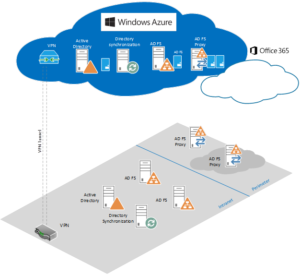Microsoft Azure: Single Sign-on (SSO)
Microsoft Azure Blog Series
Organizations of all kinds and sizes are still adopting new cloud solutions and tools to use within their business. SaaS (Software as a Service) applications are very popular with organizations because of the simplicity of deployment and scaling. As the number of SaaS apps grow, it becomes challenging for administrators to manage accounts and access rights. It becomes just as challenging for users to remember all their different passwords. Not to mention that managing these applications individually creates extra work and is less secure. Security becomes an issue for two main reasons: 1. employees can’t remember all their passwords, so they begin writing them down or saving them in a file on their computer, neither of which is smart or secure. 2. SaaS applications are easy to get, so employees start using them on their own doing, causing the IT department to be ignorant to their existence, so they are not being properly monitored.

Microsoft recognized the issue that organizations are facing with the increased SaaS adoption and offer a solution through Azure with single sign-on (SSO). It’s the simplest way to manage multiple apps and provide users with a consistent sign-on experience. Azure Active Directory (Azure AD) provides a robust SSO solution and has many available pre-integrated applications, with tutorials for admins to quickly set up a new app and start provisioning users. Azure AD allows you to integrate your apps and provisioned accounts by using 1 of 2 approaches.
- If the app is pre-integrated in the app Gallery, you can go through that portal to set up apps and configure the settings to allow SSO. For any Gallery app, you can get started by follow the simple step-by-step instructions presented in the app gallery and in the Azure portal to enable single sign-on.
- If the app is not in the Gallery, you can still set up most apps in Azure AD as a custom app. This requires a bit more technical expertise to configure. You can add any application that supports SAML 2.0 as a federated app, or any application that has an HTML-based sign-in page as a password SSO app.
To get started setting up single sign-on for an app that you’re bringing into your organization, you will be using an existing directory in Azure Active Directory (Azure AD). 2W Tech is a Tier 1 Level Microsoft Partner and has Microsoft Azure Expert Consultants of staff. Contact us today and learn more about Azure Cloud and SSO.
Read More:
Manufacturing Skyrocking: Is Your Technology Ready?
Manufacturing Software Uncomplicates
Building a Business Case for Business Continuity Whitepaper
Enjoyed reading this article? Click the button below to download this asset.
Download “Business Continuity Whitepaper” Now
Building a Business Case for Business Continuity
Please complete the form to download the file.